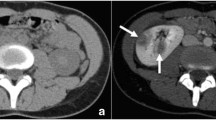Abstract
Pyelonephritis is a potentially lethal disease occasionally encountered in the forensic setting. Post mortem computed tomography (PMCT) is an important investigative tool for the forensic pathologist. In particular, it may be used to document and screen disease prior to traditional autopsy methods. While the sensitivity and specificity of computed tomography for pyelonephritis is well studied in the antemortem clinical setting, the test characteristics of PMCT are not yet described in the forensic pathology literature. A series of all cases of fatal pyelonephritis identified at the Ontario Forensic Pathology Service, over the course of 1 year was studied. Radiologic, clinical and pathologic findings were reviewed. A fulsome autopsy, including histopathologic examination, was considered the gold standard for sensitivity and specificity calculations. A control group consisting of 16 cases without pyelonephritis (ex: opiate toxicity) in which both PMCT and histologic data were available by way of comparison. Sixteen cases of pyelonephritis were identified. Post mortem computed tomographical signs of pyelonephritis included asymmetric renal enlargement, perinephric fat stranding, and ectopic renal air. The most (57%) individually sensitive of these findings was perinephric fat stranding but sensitivity increased to 100% if any of the three signs were present. The control group analysis revealed the specificity of air asymmetry (81%), asymmetric renal enlargement (81%), and fat stranding (69%). PMCT findings may rule in a diagnosis of pyelonephritis, and should prompt the pathologist to grossly and microscopically examine the kidneys.


Similar content being viewed by others
References
Williams AS, Dmetrichuk JM, Kim P, Pollanen MS. Postmortem radiologic and pathologic findings in COVID-19: the Toronto experience with pre-hospitalization deaths in the community. Forensic Sci Int. 2021;322: 110755.
Grabherr S, Heinemann A, Vogel H, Rutty G, Morgan B, Woźniak K, et al. Postmortem CT angiography compared with autopsy: a forensic multicenter study. Radiology. 2018;288:270–6.
Garland J, Olds K, Tse R. Perinephric fat stranding on postmortem computed tomography scan in acute pyelonephritis: a case report. Am J Forensic Med Pathol. 2019;40:391–3.
Craig WD, Wagner BJ. Travis MD. Pyelonephritis: radiologic-pathologic review. Radiographics. 2008;28:255–76.
Huang JJ, Tseng CC. Emphysematous pyelonephritis: clinicoradiological classification, management, prognosis, and pathogenesis. Arch Intern Med. 2000;160:797–805.
Anumudu S, Eknoyan G. Pyelonephritis: a historical reappraisal. JASN. 2019;30:914–7.
Jennette JC, Olson JL, Silva FG, D’Agati V, Heptinstall RH, editors. Heptinstall’s pathology of the kidney. 7th ed. Philadelphia: Wolters Kluwer; 2015.
Sehgal P, Pollanen M, Daneman N. A retrospective forensic review of unexpected infectious deaths. Open Forum Infect Dis. 2019;6:ofz081.
Andrews SW. Postmortem changes as documented in postmortem computed tomography scans. Acad Forensic Pathol. 2016;6:63–76.
Borowska-Solonynko A, Koczyk K, Blacha K, Prokopowicz V. Significance of intracranial gas on post-mortem computed tomography in traumatic cases in the context of medico-legal opinions. Forensic Sci Med Pathol. 2020;16:3–11.
Tanizaki R, Ichikawa S, Takemura Y. Clinical impact of perinephric fat stranding detected on computed tomography in patients with acute pyelonephritis: a retrospective observational study. Eur J Clin Microbiol Infect Dis. 2019;38:2185–92.
Egger C, Vaucher P, Doenz F, Palmiere C, Mangin P, Grabherr S. Development and validation of a postmortem radiological alteration index: the RA-Index. Int J Legal Med. 2012;126:559–66.
Levy AD, Harcke HT, Mallak CT. Postmortem imaging: MDCT features of postmortem change and decomposition. Am J Forensic Med Pathol. 2010;31:12–7.
Sourtzis S, Thibeau JF, Damry N, Raslan A, Vandendris M, Bellemans M. Radiologic investigation of renal colic: unenhanced helical CT compared with excretory urography. Am J Roentgenol. Am Roentgen Ray Soc. 1999;172:1491–4.
Westphalen A, Yeh B, Qayyum A, Hari A, Coakley FV. Differential diagnosis of perinephric masses on CT and MRI. AJR Am J Roentgenol. 2004;183:1697–702.
Magnin V, Grabherr S, Michaud K. The Lausanne forensic pathology approach to post-mortem imaging for natural and non-natural deaths. Diagn Histopathol. 2020;26:350–7.
Acknowledgements
The authors would like to acknowledge Ms. Cianna Williams, Quality Analyst at the Ontario Forensic Pathology Service, who did the important work of searching the forensic databases for relevant cases.
Author information
Authors and Affiliations
Corresponding author
Ethics declarations
Conflict of interest
The authors declare no competing interests.
Additional information
Publisher's Note
Springer Nature remains neutral with regard to jurisdictional claims in published maps and institutional affiliations.
Rights and permissions
Springer Nature or its licensor holds exclusive rights to this article under a publishing agreement with the author(s) or other rightsholder(s); author self-archiving of the accepted manuscript version of this article is solely governed by the terms of such publishing agreement and applicable law.
About this article
Cite this article
Gershon, A., Kim, P.J.H. & Ball, C.G. Post mortem computed tomography is highly sensitive for pyelonephritis. A radiologic-pathologic correlation series. Forensic Sci Med Pathol 18, 450–455 (2022). https://doi.org/10.1007/s12024-022-00540-y
Accepted:
Published:
Issue Date:
DOI: https://doi.org/10.1007/s12024-022-00540-y




